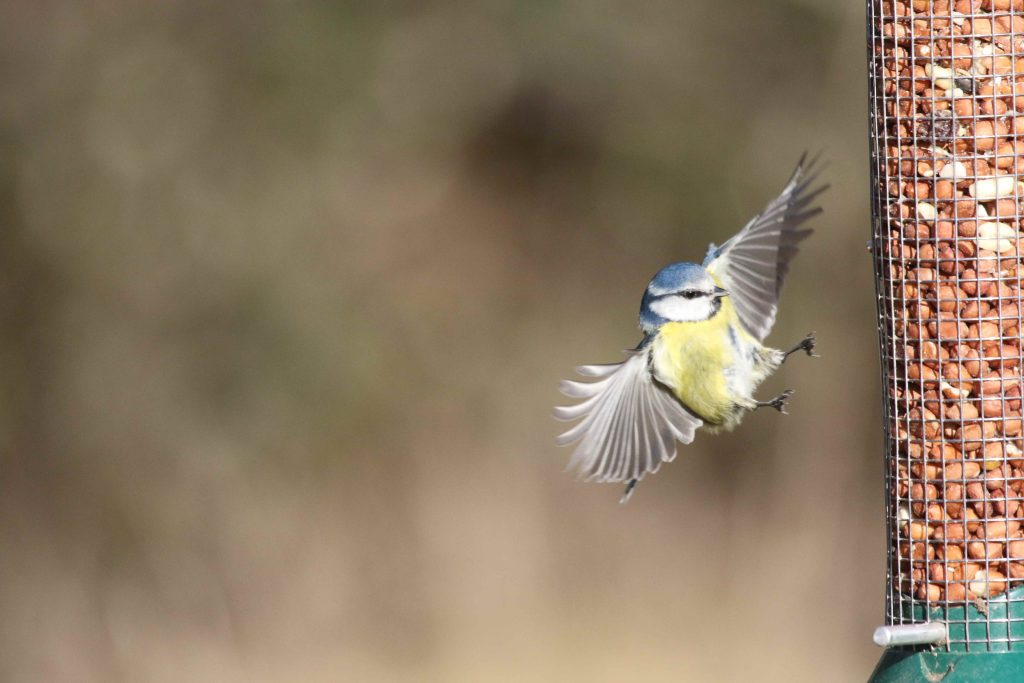Swings and roundabouts
Having moved to a new urban address 12 months ago, it was noticeable how much of a challenge lay ahead in building bird numbers and species variety. But having stuck with the challenge and having ‘deployed’ a range of food to tempt the birds in, my patience has paid off. This spring has seen a good number of young blackbirds pay a visit to enjoy the water on offer almost as much as the food being offered by their parents.
Goldfinches have appeared, including a visit by a recently fledged youngster into the conservatory! This isn’t the only visitor we’ve had, a young robin decided to take a look in the kitchen a few weeks ago. Collard doves have returned to timidly wait for the wood pigeons to vacate the bird table before having something to eat. Overall there has been a noticeable improvement in both the number and the variety of birds visiting.
But there is always a negative to every positive, and for us this year, it has been a noticeable decline in blue tits. Spring saw good numbers of birds visiting, feeding and prospecting the nest boxes on offer. They even made off with the nest material we left out for them, but since then, it has become rare to see one in the garden. We’ve done our best to be a ‘No Mow May’ garden and have given over even more of the garden to wildflowers and weeds in an effort to attract pollinators. Despite this, the number of blue tits has fallen to almost zero.
The lack of blue tits could be linked to the lack of insects, and in particular, caterpillars. With the spring being cold and then hot, followed by a significant dry period, it’s logical to link the drop in blue tit numbers to a reduction in their primary food source. No doubt, the BTO’s nest box survey will provide more information on blue tit nesting successes or failures in due course.
But in nature, there is often a positive to outweigh the negatives, and so far this year, I’ve seen more swallows, swifts and house martins flying over the garden than in previous years. It is always good to see these summer visitors who have suffered significant population reductions over the last few years. A major factor has been (and continues to be) the loss of suitable nest sites, but a reduction in flying insects is also had an impact. So while it could have been a bad year for some, it has been a better year for others. As ever in nature, swings and roundabouts.
© Phil Pickin
Goldfinches have appeared, including a visit by a recently fledged youngster into the conservatory! This isn’t the only visitor we’ve had, a young robin decided to take a look in the kitchen a few weeks ago. Collard doves have returned to timidly wait for the wood pigeons to vacate the bird table before having something to eat. Overall there has been a noticeable improvement in both the number and the variety of birds visiting.
But there is always a negative to every positive, and for us this year, it has been a noticeable decline in blue tits. Spring saw good numbers of birds visiting, feeding and prospecting the nest boxes on offer. They even made off with the nest material we left out for them, but since then, it has become rare to see one in the garden. We’ve done our best to be a ‘No Mow May’ garden and have given over even more of the garden to wildflowers and weeds in an effort to attract pollinators. Despite this, the number of blue tits has fallen to almost zero.
The lack of blue tits could be linked to the lack of insects, and in particular, caterpillars. With the spring being cold and then hot, followed by a significant dry period, it’s logical to link the drop in blue tit numbers to a reduction in their primary food source. No doubt, the BTO’s nest box survey will provide more information on blue tit nesting successes or failures in due course.
But in nature, there is often a positive to outweigh the negatives, and so far this year, I’ve seen more swallows, swifts and house martins flying over the garden than in previous years. It is always good to see these summer visitors who have suffered significant population reductions over the last few years. A major factor has been (and continues to be) the loss of suitable nest sites, but a reduction in flying insects is also had an impact. So while it could have been a bad year for some, it has been a better year for others. As ever in nature, swings and roundabouts.
© Phil Pickin



